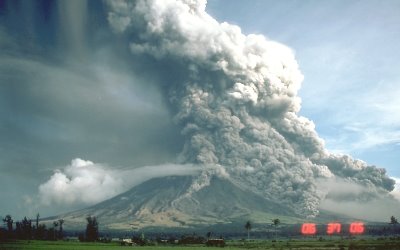Thursday, August 24, 2006
This Day in Ancient History
 On this day in 79 AD, Vesuvius erupts and a pyroclastic cloud descends on Pompeii, Strabia, Herculaneum and hundreds of individual villas scattered over the Compania between the volcano and the Bay of Naples. Everyone within the flow is killed by an 400 degree rock, ash and gas cloud traveling at hundreds of miles per hour. The buried towns wait for nearly 1700 hundred years to be released from the burying ash and tephrite.
On this day in 79 AD, Vesuvius erupts and a pyroclastic cloud descends on Pompeii, Strabia, Herculaneum and hundreds of individual villas scattered over the Compania between the volcano and the Bay of Naples. Everyone within the flow is killed by an 400 degree rock, ash and gas cloud traveling at hundreds of miles per hour. The buried towns wait for nearly 1700 hundred years to be released from the burying ash and tephrite.
The flow that buried the Roman towns is called a base surge and it is created when the initial eruption heats the air insufficiently to carry the cloud clear away on convection currents. The towering plume falls back to earth and down the sides of the volcano. Above is a 1986 photo of a base surge down the side of a volcano in the Philippine Islands. To the right is Karl Briullov's 1830s painting The Last Day of Pompeii with lots of Roman histrionics but nary a hurtling pumice stone to be seen.
Comments:
<< Home
For a well-written fictionalized account of the eruption of Pompeii (written from the POV of an aqueduct engineer, you might want to take a look at Robert Harris's Pompeii.
Regrettably, I'll probably not be able to make it; I have a prior commitment IIRC, David originally announced this for Saturday, which would have worked fine, but Fridays are usually out for me.
Post a Comment
<< Home



